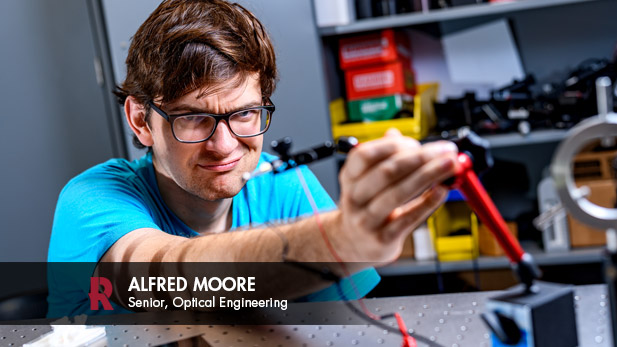Senior Alfred Moore Honored Nationally for Creating Innovative Auto Lighting Techniques

Optical engineering student Alfred Moore earned a top design award in the 2023 Robert S. Hilbert Memorial Optical Design Competition for a low-beam headlamp that meets performance and automotive industry standards.
An optical engineering classroom project has become a bright idea for innovative automotive lighting technology that’s earned senior Alfred Moore national recognition, recent publication in an international optics journal, and possible patent protection filing. Then, the technology may be applied to future commercial lighting systems.
Moore was one of 17 North America college students earning a top design award in the prestigious 2023 Robert S. Hilbert Memorial Optical Design Competition. The program highlights commendable research projects designed by bachelor’s, master’s or doctorate degree-seeking students using Synopsys Optical Solutions software. Other colleges with award winners this year included California Institute of Technology, University of Arizona, University of Central Florida, and University of Rochester (New York).
This is the third time that a Rose-Hulman student has been recognized by Synopsys for projects developed in a course taught by Hossein Alisafaee, PhD, that introduces students to automotive lighting technology.
Moore designed a low-beam headlamp with a light-emitting diode and fold mirror to create a folded light source that meets performance and automotive industry standards. This technique could allow optical engineers to design more compact and energy-efficient products for automotive headlamps and general lighting applications.
The project was developed as part of Alisafaee’s project-based course last spring in which students learn and then apply practical design procedures for automotive lighting applications. Students come up with their own creative forward and rear lighting ideas on four projects using different vehicular lamps.
“The folded light source project that I developed increases the optical efficiency of illumination systems, with the prospect of achieving considerable improvement through more testing, research, and development,” said Moore. “It’s interesting to apply what you’re learning in class to a hands-on project that could have applications for the future implementation in industry.”
A research paper written by Moore and Alisafaee has been published in the September issue of Optical Engineering, a prestigious journal that features peer-reviewed articles reporting on research, development, and applications of optics and photonics. The student and professor also plan to file a patent about their technology innovation with the United States Patent and Trademark Office.
“Alfred’s fine work and achievements stack up with the work being done by graduate- and PhD-level students, and he wasn’t alone. Other students in my class last spring developed innovative projects that are cutting-edge in their techniques,” said Alisafaee, who is director of the Department of Physics and Optical Engineering’s Center for Applied Optics Studies.
Rose-Hulman optical engineering graduates have gone on to work and have internships in automotive lighting with North American Lighting, Valeo, Magna Lighting, along with developing lighting technologies with Magnalux Lighting, Grote Industries, and Flex-N-Gate Lighting. Rose-Hulman’s past Synopsys award winners Cody Brelage (2023 optical engineering alumnus) and Audrey Brand (2020 optical engineering alumna) are now working as system engineers with Naval Surface Warfare Center and Thermo Fisher Scientific Inc., respectively.
“Dr. Alisafaee really encourages us to develop innovative designs that will continue to make the lighting industry more energy efficient and accommodating for new classes of vehicles,” said Moore, who is seeking a career in the lighting industry. Skills gained through his Rose-Hulman education have been enhanced during research internships with Massachusetts Institute of Technology’s Lincoln Laboratory and the University of Washington.
“I like examining how a beam of light can be intensified through techniques like mirror manipulation. Developments are constantly being made in this field and I would like to see what contributions I could make,” said the Cincinnati, Ohio, native.